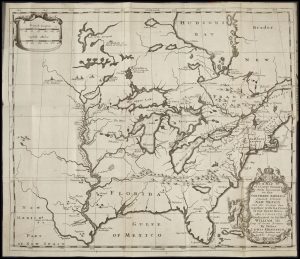In recent years, there has been an effort among educators, music educators in particular, to diversify the pedagogical canon of repertoire, particularly with works by indigenous composers or with indigenous subjects. However current efforts to study indigenous music fall into some of the same issues as early colonizers.

Hennepin, Lewis. “Map of a Large Country Newly Discovered in the Northern America.” American History Indians and Culture, Amdigital.Co.Uk.
The map above, by cartographer Lewis Hennepin, depicts the area to become the US around the 1690s. Wide swaths of inhabited areas are marked empty, or are missing groups living in those areas. Wide swaths of land are generically referred to as Iroquois or Illinois, in a somewhat reductionist view of indigenous tribes – understood by current historians to have been significantly more complex1.
In studies of indigenous music, mythical ideas of racial essences that are deeply embedded within the folk culture of U.S. society have to be recognized so that romanticized stereotypes may be challenged2. The effort by some musicologists to “essentialize” indigenous music makes the same reductionist mistake as colonial explorers and disregards the complexity and details of indigenous cultures.
Even the Library of congress refers to indigenous music as a monolith, assembling instructions for how best to prepare to study native American musical traditions often lumps cultural traditions with little attention to differentiation or individual tribal identities. Thankfully the Library of Congress is careful to note that it is important to best appreciate music within its context3.
This contextualization is critical especially as there is the modern push to play and study more indigenous music. Prest notes the large influx of pieces attempting to celebrate indigenous culture that end up being largely reductionist and nearly downright insensitive4. He also notes that often western musicologists approach indigenous music with a self-serving attitude, approaching music wondering what they could gain from it. He also notes that attempts to integrate music tend to try and be inclusive while subverting the history of genocide committed against indigenous people. So as pedagogues look to make the noble push to diversify their repertoire, they must make sure to do so with careful attention to detail, that often starts with talking to and listening to indigenous scholars.
1 Malinowski, Sharon. “IROQUOIS CONFEDERACY.” Iroquois Confederacy – CPN Cultural Heritage Center, www.potawatomiheritage.com/encyclopedia/iroquois-confederacy/#:~:text=The%20Iroquois%20Confederacy%20or%20the,North%20Carolina%2C%20joined%20the%20Confederacy. Accessed 26 Oct. 2023.
2 Eisenbeil, Bruce. “Native American Perspectives in Music – Post #1 (2 of 2).” Bruce Eisenbeil, www.eisenbeil.com/native-american-perspectives-in-music-post-1-2-of-2-2/. Accessed 26 Oct. 2023.
3 Appold, Juliette. “Appreciating Native American Music: NLS Music Notes.” The Library of Congress, The Library of Congress, 4 Nov. 2021, blogs.loc.gov/nls-music-notes/2021/11/appreciating-native-american-music/#:~:text=Its%20most%20traditional%20instruments%20are,to%20draw%20on%20traditional%20contents.
4 Prest, A., Goble, J. S., & Vazquez-Cordoba, H. (2023). On Embedding Indigenous Musics in Schools: Examining the Applicability of Possible Models to One School District’s Approach. Update: Applications of Research in Music Education, 41(2), 60-69. https://doi.org/10.1177/87551233221085739
